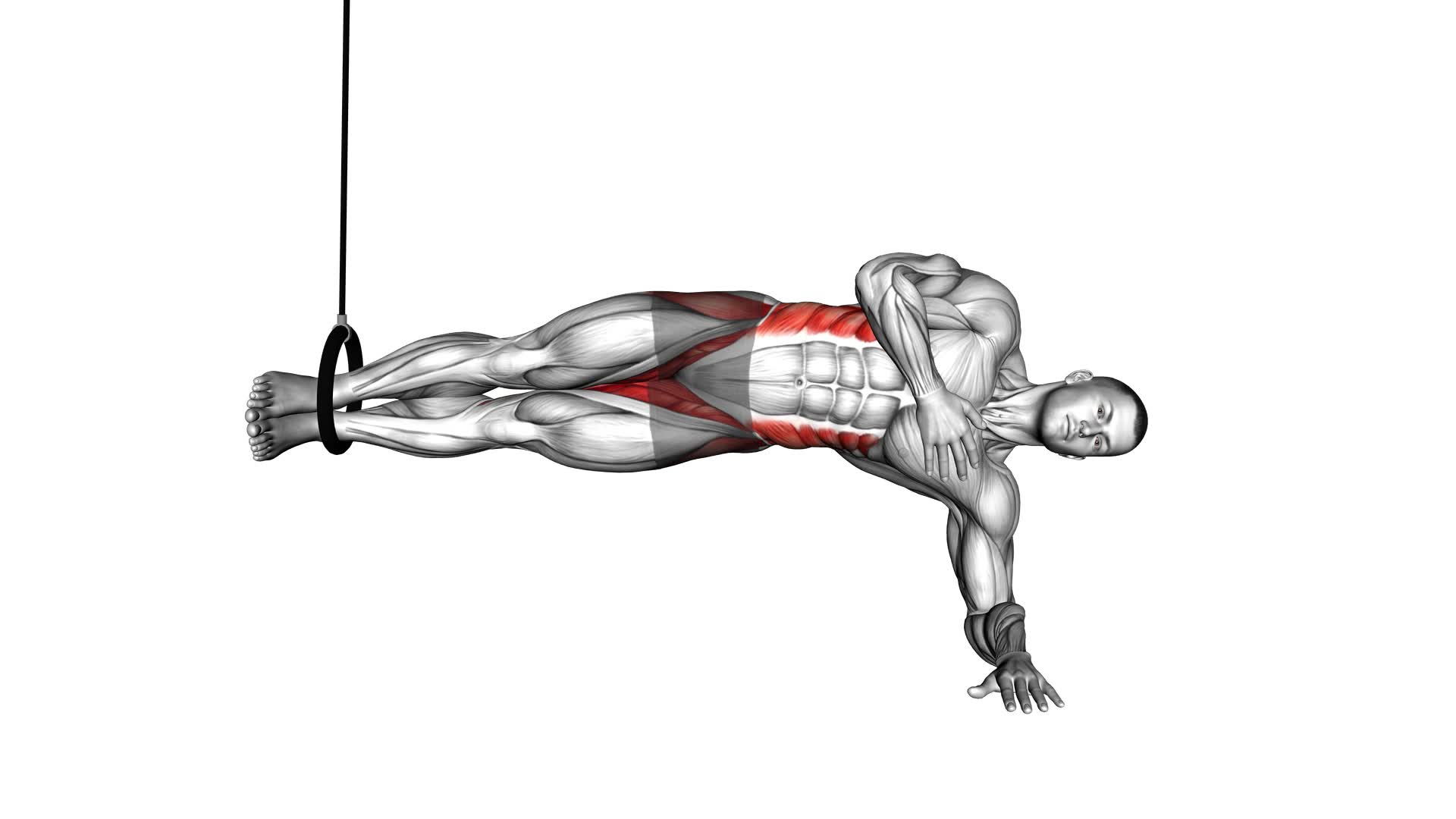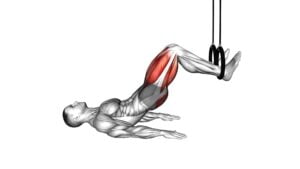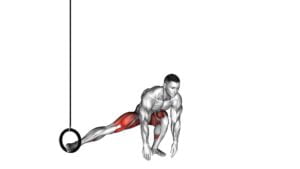Ring Side Bridge (male) – Video Exercise Guide & Tips

Are you looking to strengthen your core and improve your overall stability? Look no further than the Ring Side Bridge!
Watch This Exercise Video
In this video exercise guide, we'll show you the proper form and technique for performing this challenging exercise. With variations and progressions to suit your fitness level, you'll be able to target your obliques and build a stronger midsection.
Get ready to take your workout routine to the next level with the Ring Side Bridge!
Key Takeaways
- Targets obliques and builds a stronger midsection
- Engages core muscles, improving posture and stability
- Improves shoulder stability and strengthens upper body muscles
- Versatile exercise with modifications for different fitness levels
Benefits of the Ring Side Bridge
Get ready to experience the many benefits of the Ring Side Bridge. This exercise isn't only effective but also versatile, allowing for modifications to suit your fitness level and goals.
One of the key benefits of the Ring Side Bridge is that it focuses on unilateral training. By working one side of your body at a time, you can address any muscle imbalances and develop better overall strength and stability. This is especially beneficial for athletes who need to perform unilateral movements in their sports.
Additionally, the Ring Side Bridge engages your core muscles, including your obliques, transverse abdominis, and glutes. Strengthening these muscles can improve your posture, stability, and even help alleviate lower back pain.
Moreover, the Ring Side Bridge also improves shoulder stability and strengthens the muscles of the upper body, including the deltoids and trapezius.
Now that you understand the benefits of the Ring Side Bridge, let's move on to proper form and technique to ensure you get the most out of this exercise.
Proper Form and Technique for the Ring Side Bridge
To ensure you get the most out of the Ring Side Bridge and maximize its benefits, it's important to focus on proper form and technique. The Ring Side Bridge is an effective exercise for building core strength and improving stability.
When performing the Ring Side Bridge, start by lying on your side with your forearm resting on the ground and your legs extended straight. Stack your feet on top of each other and lift your body off the ground, creating a straight line from your head to your feet. Engage your core muscles and hold this position for a set amount of time or repetitions.
To maintain proper form, make sure to keep your body aligned throughout the exercise. Avoid sagging or arching your back, as this can put unnecessary strain on your spine. Instead, focus on keeping your core engaged and your hips lifted.
The benefits of core strength include improved posture, reduced risk of injury, and increased athletic performance. Additionally, having a strong core can enhance your overall stability and balance in everyday activities.
Equipment Needed for the Ring Side Bridge
You will need minimal equipment for the Ring Side Bridge. Here are the five items you'll need:
- Exercise mat: A comfortable mat will provide cushioning and support for your body during the exercise.
- Stopwatch or timer: Keeping track of time is essential for monitoring your progress and ensuring that you hold the position for the recommended duration.
- Stability ball (optional): Using a stability ball can add an extra challenge to the exercise by engaging more muscles and improving balance.
- Resistance band (optional): Incorporating a resistance band into the exercise can increase the intensity and provide additional resistance for a more challenging workout.
- Water bottle: Staying hydrated is important during any workout to prevent dehydration and maintain optimal performance.
The Ring Side Bridge is a highly effective exercise that targets the core muscles, including the abs, obliques, and lower back. It also helps improve stability, balance, and posture. The exercise can be modified to suit different fitness levels by adjusting the duration and intensity. Beginners can start with shorter hold times and fewer repetitions, while advanced individuals can increase the duration and add resistance.
It's important to listen to your body and make modifications as needed to ensure proper form and avoid any discomfort or injury. Incorporating the right equipment can enhance the benefits of the Ring Side Bridge and provide a more challenging workout.
Variations and Progressions of the Ring Side Bridge
Now that you've mastered the basic Ring Side Bridge, it's time to challenge yourself with advanced progressions. These variations will take your core and upper body strength to the next level.
But be careful to avoid common mistakes that can hinder your progress.
By incorporating these variations into your routine, you'll reap the benefits of increased stability, muscular endurance, and overall functional fitness.
Advanced Progressions for Ring Side Bridge
As you progress in your training, incorporating variations and progressions of the Ring Side Bridge will challenge your core stability and increase the intensity of your workouts.
Here are some advanced modifications to try:
- Elevated Ring Side Bridge: Place your feet on an elevated surface, such as a box or bench, to increase the difficulty and activate your core muscles even more.
- Weighted Ring Side Bridge: Hold a dumbbell or kettlebell in one hand while performing the exercise to add resistance and further engage your muscles.
- Ring Side Plank with Leg Lift: From the side plank position, lift your top leg up and hold for a few seconds before lowering it back down. This targets your glutes and adds an extra challenge to your stability.
- Ring Side Bridge with Knee Tuck: While in the bridge position, bring your knee towards your chest and then extend it back out. This variation works your hip flexors and increases the demand on your core.
- Ring Side Bridge with Arm Reach: Extend your top arm straight up towards the ceiling while holding the bridge position. This engages your shoulder muscles and adds an upper body component to the exercise.
Incorporating these advanced progressions will take your Ring Side Bridge to the next level, providing a greater challenge to your core stability and muscle activation.
Common Mistakes to Avoid
To ensure proper form and maximize the effectiveness of variations and progressions of the Ring Side Bridge, it's important to avoid common mistakes.
One common mistake isn't engaging your core muscles properly. Remember to brace your core and maintain a straight line from your head to your heels throughout the exercise.
Another mistake is letting your hips sag or rotate. Keep your hips lifted and in line with your shoulders to avoid strain on your lower back.
Lastly, avoid rushing through the exercise. Take your time to perform each repetition with control and focus on maintaining proper technique.
Benefits of Variations
To maximize your results and challenge your body in new ways, try incorporating variations and progressions of the Ring Side Bridge. By adding these variations to your routine, you can target different muscle groups and enhance the overall effectiveness of the exercise. Here are some benefits of incorporating variations into your Ring Side Bridge workout:
- Increased core stability: Variations like the Single Leg Ring Side Bridge or the Ring Side Bridge with Leg Lift engage your core muscles even more, helping to improve stability and balance.
- Greater hip mobility: Trying out variations like the Ring Side Bridge with Hip Abduction or the Ring Side Bridge with Hip Extension can help increase hip mobility and flexibility.
- Added upper body strength: Variations that involve incorporating arm movements, such as the Ring Side Bridge with Arm Reach or the Ring Side Bridge with Arm Circle, can help improve your upper body strength.
- Enhanced coordination: By challenging your body with different forms of the Ring Side Bridge, you can improve your coordination and body control.
- Overall muscle development: Incorporating variations targets different muscle groups, leading to more comprehensive muscle development and improved overall fitness.
Common Mistakes to Avoid While Performing the Ring Side Bridge
- Ensure you avoid these common mistakes while performing the Ring Side Bridge. Proper alignment and muscle activation are crucial for maximizing the benefits of this exercise.
Firstly, be mindful of your body alignment. Avoid sinking into your shoulder or hip, as this can put unnecessary strain on your joints. Instead, aim to maintain a straight line from your head to your heels. Engage your core muscles to stabilize your body and prevent any sagging or arching.
Secondly, ensure proper muscle activation. Many people make the mistake of relying solely on their shoulder and hip muscles to hold the position. To fully engage the targeted muscles, focus on activating your glutes and obliques. Squeeze your glutes and pull your belly button towards your spine to engage the necessary muscles for a stronger and more effective side bridge.
Lastly, avoid rushing through the exercise. Take your time to find the correct alignment and activate the muscles properly before starting the movement. This will help you maintain proper form and get the most out of each repetition.
Tips for Incorporating the Ring Side Bridge Into Your Workout Routine
To effectively incorporate the Ring Side Bridge into your workout routine, it's crucial to focus on proper form techniques. Make sure to engage your core and maintain a straight line from your head to your heels throughout the exercise.
Additionally, consider trying variations of the Ring Side Bridge that cater to your fitness level, such as adding a leg raise or using a stability ball for an extra challenge.
Proper Form Techniques
Incorporate proper form techniques into your workout routine when performing the Ring Side Bridge. Using the correct form not only maximizes the benefits of this exercise but also helps prevent common mistakes that can lead to injury.
Here are some tips to keep in mind:
- Maintain a straight line from your head to your toes throughout the exercise.
- Engage your core muscles by squeezing your abs and glutes.
- Keep your shoulder blades pulled back and down to avoid shrugging.
- Avoid arching your lower back by tucking your pelvis slightly.
- Breathe steadily and avoid holding your breath.
Variations for All Levels
Try different variations of the Ring Side Bridge to challenge yourself and incorporate this exercise into your workout routine.
If you're a beginner, start with the basic variation by lying on your side with your legs straight and feet stacked on top of each other. Lift your hips off the ground, creating a straight line from your head to your feet. Hold for a few seconds and then lower back down.
For advanced modifications, you can try lifting your top leg off the bottom leg while maintaining the bridge position. This will increase the intensity and engage your core and glutes even more.
Remember to keep proper form throughout all variations and listen to your body to avoid any injuries.
Frequently Asked Questions
How Many Calories Does the Ring Side Bridge Burn?
The ring side bridge is a great exercise for burning calories. It helps engage your core and stabilizer muscles, which can increase your calorie burn.
Incorporating ring side bridge variations into your workout routine can provide even more benefits. It can improve your balance, increase your core strength, and enhance your overall body stability.
Can the Ring Side Bridge Help With Reducing Back Pain?
The ring side bridge can be a helpful exercise for reducing back pain.
To perform it correctly, start by lying on your side with your legs extended and your forearm supporting your upper body.
Lift your hips off the ground, creating a straight line from your head to your feet.
Hold for a few seconds and then lower back down.
There are variations of the ring side bridge that can be adapted to different fitness levels.
Is the Ring Side Bridge Suitable for Beginners?
The Ring Side Bridge is a great exercise for beginners looking to strengthen their core and improve stability. It targets the obliques and helps with overall body control.
If you're new to this exercise, there are modifications you can try to make it more accessible. You can start by performing the Ring Side Bridge with your knees bent or by using a stability ball for support.
As you progress, you can explore different variations to challenge yourself further.
Can the Ring Side Bridge Improve Core Strength?
The ring side bridge is a great exercise for improving core strength. By incorporating ring side bridge variations into your workout routine, you can target and strengthen your abs, obliques, and lower back muscles.
Core strength training has numerous benefits, such as improving posture, stability, and overall athletic performance.
How Often Should the Ring Side Bridge Be Performed to See Results?
To see results from the ring side bridge, you should perform it regularly. The frequency of your workouts depends on your fitness level and goals. Aim to do the ring side bridge at least 2-3 times a week, allowing for rest days in between.
It's important to vary your routine by incorporating different ring side bridge variations to challenge your core muscles. Remember to maintain proper form throughout the exercise for maximum effectiveness.
Conclusion
Incorporating the ring side bridge into your workout routine can offer numerous benefits. This exercise is known for strengthening your core, improving stability, and enhancing overall body strength. By following proper form and technique, you can maximize the effectiveness of this exercise.
To perform the ring side bridge, you will need the necessary equipment, such as gymnastic rings. It is important to ensure that the rings are properly set up and secure before starting the exercise.
While performing the ring side bridge, it is crucial to avoid common mistakes. This includes keeping your body in a straight line, engaging your core muscles, and avoiding excessive movement or swinging.
Remember to start with variations and progressions that suit your fitness level. It is important to gradually challenge yourself as you become more comfortable with the exercise. This will help you continue to see improvements and avoid plateauing.
So, if you're looking to strengthen your core, improve stability, and enhance overall body strength, give the ring side bridge a try. Incorporating this exercise into your workout routine can take your fitness to new heights!

Author
Years ago, the spark of my life’s passion ignited in my mind the moment I stepped into the local gym for the first time. The inaugural bead of perspiration, the initial endeavor, the very first surge of endorphins, and a sense of pride that washed over me post-workout marked the beginning of my deep-seated interest in strength sports, fitness, and sports nutrition. This very curiosity blossomed rapidly into a profound fascination, propelling me to earn a Master’s degree in Physical Education from the Academy of Physical Education in Krakow, followed by a Sports Manager diploma from the Jagiellonian University. My journey of growth led me to gain more specialized qualifications, such as being a certified personal trainer with a focus on sports dietetics, a lifeguard, and an instructor for wellness and corrective gymnastics. Theoretical knowledge paired seamlessly with practical experience, reinforcing my belief that the transformation of individuals under my guidance was also a reflection of my personal growth. This belief holds true even today. Each day, I strive to push the boundaries and explore new realms. These realms gently elevate me to greater heights. The unique combination of passion for my field and the continuous quest for growth fuels my drive to break new ground.







